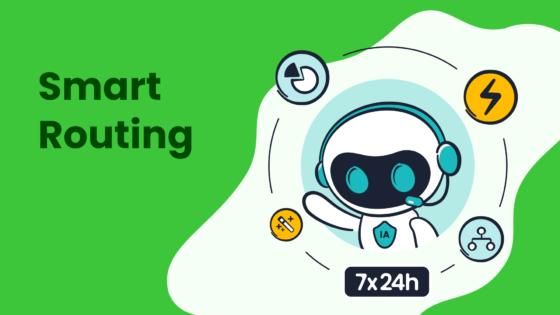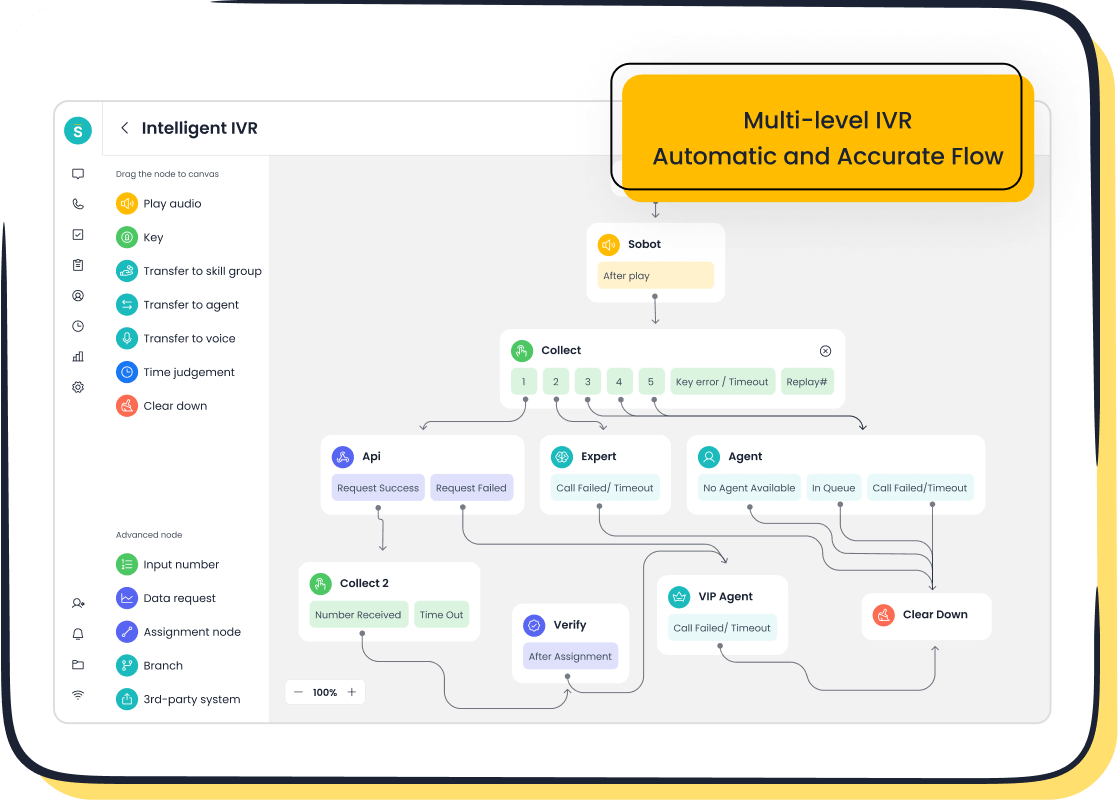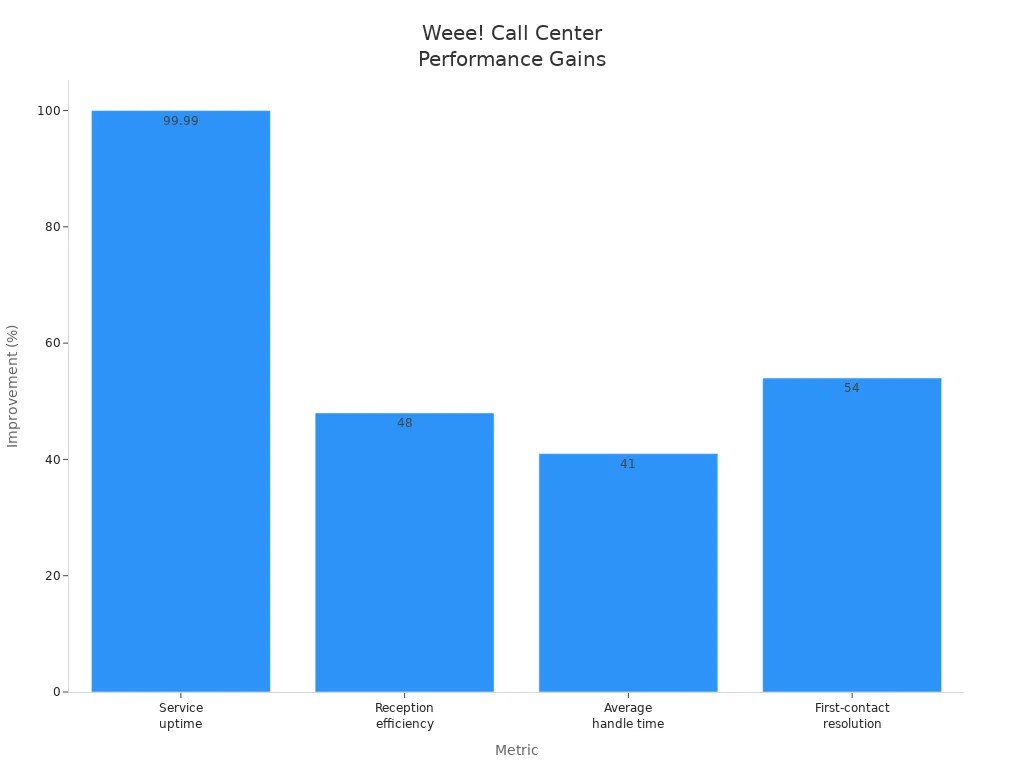Is Call Center Call Routing Software Right for Your Business

Do you struggle to connect your customers to the right agents quickly? You might find that your current call center software cannot handle high call volumes or unique customer needs. Many businesses search for a solution that improves both agent productivity and customer satisfaction. The right call center call routing software can transform your operations. You want a solution that matches your business size, industry, and customer expectations. Sobot leads as one of the most innovative call center software providers. Sobot AI powers the Sobot call center, delivering solutions that fit your needs.
What Is Call Center Call Routing Software

Core Functions
Call center call routing software helps you direct incoming calls to the right agent or department. This software uses automatic call distribution to match callers with agents based on skills, availability, and customer history. You can connect customers faster and reduce wait times. Many cloud solutions also integrate with CRM systems, so agents see customer details right away. Some advanced call center software uses predictive behavioral routing. This means the system looks at past data and matches callers with agents who fit their needs or mood. For example, a stressed caller might reach a calm agent who knows how to help quickly. These features improve both customer satisfaction and agent performance.
Routing Methods
You can choose from many routing methods in modern call center software. Each method has its own strengths and weaknesses. Here is a table to help you compare:
| Routing Method | Description | Pros | Cons |
|---|---|---|---|
| Skill-based routing | Matches calls to agents with the right skills | Better first-call resolution | Needs skilled agents and setup |
| Value-based routing | Prioritizes high-value customers | Protects revenue, improves retention | Risk of misrouting if used alone |
| Geographic routing | Connects callers to local agents | Reduces handling time | Can overload regions |
| Time-based routing | Routes calls by time of day or week | Manages shifts and peak times | May ignore agent skills |
| Least occupied routing | Sends calls to least busy agents | Balances workload | Ignores skills and customer needs |
| IVR routing | Uses menu choices to direct calls | Reduces misrouted calls | Poor design can frustrate customers |
| Campaign-based routing | Routes by marketing campaign numbers | Tracks campaign success | Multiple numbers may confuse customers |
Cloud and hosted call center platforms often let you mix these methods for the best results.
Industry Applications
Many industries use call center call routing software to improve service. Healthcare, e-commerce, finance, and retail all rely on automatic call distribution to connect customers with the right help. In healthcare, you can route patients to nurses or billing staff. E-commerce companies use cloud call center software to handle order questions and returns. Hosted call center solutions help financial firms manage sensitive calls securely. These systems often work with chatbots, omnichannel platforms, and workforce tools. You get faster response times, better customer experiences, and more efficient teams.
Who Needs Call Center Software
Business Types
You can find value in call center software if your business handles many customer calls each day. Small and medium businesses often choose cloud-based call center software because it is easy to scale and does not need much hardware. Large companies with thousands of customers may use on-premise or open source call center software for more control and customization. Many industries benefit from these tools, including retail, healthcare, finance, and e-commerce. If your business needs to connect customers to the right agent quickly, call center software can help. Open source call center software also works well for companies that want to build custom features or manage their own systems.
- Call center software helps companies of all sizes.
- Businesses with high call volumes see the most improvement.
- Open source call center software gives more flexibility for unique needs.
Key Indicators
You should look at your call center’s performance to decide if you need new software. High transfer rates, long wait times, and many abandoned calls show that your current system may not work well. The table below lists some key indicators:
| KPI Name | What It Means | Why It Matters for Call Center Software | How to Improve with Software |
|---|---|---|---|
| Transfer Rate | Calls sent to other agents | High rates mean poor routing | Use smart routing features |
| Average Speed of Answer | How fast agents pick up calls | Slow answers frustrate customers | Automate call distribution |
| Call Abandonment Rate | Customers who hang up before help | High rates mean lost business | Add callback and better IVR |
| Average Handling Time | Time spent on each call | Long times increase costs | Use open source call center software tools |
| After-Call Work Time | Time spent after each call | High times lower agent availability | Automate post-call tasks |

Tip: If you see these problems often, upgrading your call center software or trying open source call center software can make a big difference.
When to Reconsider
You may want to switch or upgrade your call center software if you notice these issues:
- Your team wastes time on manual data entry or cannot track calls easily.
- You cannot add new features or connect with other business tools.
- Your current system cannot handle more calls as your business grows.
- You want agents to work from anywhere without losing service quality.
- You need advanced routing, like matching calls to the best agent every time.
Open source call center software is a good choice if you want to control your system and add custom features. Cloud-based call center software works well if you want easy setup and less hardware to manage. Both options help you improve customer service and keep up with business changes.
Pros of Call Center Call Routing Software

Customer Experience
You want your customers to feel heard and valued every time they call. Call center software with smart call routing helps you achieve this goal. When you use intelligent routing, your customers reach the right agent on the first try. This increases first call resolution and reduces the need for repeat calls. Customers spend less time waiting because the system manages queues and directs calls based on agent skills and availability.
Smart call routing also improves average wait times. The software tracks real-time data and adjusts staffing or routing to keep hold times low. When customers get quick answers, their satisfaction rises. You see fewer abandoned calls and higher loyalty. Many businesses use these tools to boost customer satisfaction and the overall quality of service.
Tip: Improving first call resolution and reducing wait times leads to better customer satisfaction and stronger customer engagement.
Agent Productivity
Your agents work best when they can focus on helping customers, not on searching for information or handling repetitive tasks. Call center software with smart call routing sends each call to the agent most prepared to help. This reduces confusion and lets agents use their skills where they matter most.
Cloud-based solutions and hosted call center platforms often include automation features. These tools handle routine tasks, such as call distribution and ticket creation. Agents spend less time on manual work and more time solving complex problems. Smart call routing also balances workloads, so no agent feels overwhelmed.
You can see the benefits in real numbers. Companies that use AI-powered routing and automation report faster response times and higher resolution rates. For example:
- AI tools guide agents in real time, reducing mistakes and speeding up answers.
- Automated scheduling prevents overstaffing or understaffing, which keeps agents productive and happy.
- Agents can focus on high-value tasks, improving the quality of customer support.
When your team works efficiently, you deliver better customer satisfaction and maintain high quality in every interaction.
Integration Benefits
You gain even more value when your call center software connects with other business tools. CRM integration gives agents instant access to customer history and preferences. This means agents can offer personalized support and resolve issues faster.
Smart call routing uses this data to match customers with the best agent for their needs. You avoid repeated questions and reduce errors. Integration with CRM and other systems also supports advanced features like call scripting, analytics, and quality monitoring. These tools help you maintain consistent quality and improve customer satisfaction.
Cloud and hosted call center solutions make integration easy. You can connect your call center software with telephony providers, ticketing systems, and omnichannel customer service platforms. This unified approach streamlines your operations and ensures agents always have the information they need.
Note: Integration eliminates duplicate data entry and boosts agent confidence in the accuracy of customer information.
Sobot Voice/Call Center Example

Sobot’s Voice/Call Center product shows how smart call routing and integration deliver real results. Sobot offers a unified workspace, intelligent IVR, and global support through its cloud platform. You can manage calls, messages, and customer data in one place, which improves both agent productivity and customer satisfaction.
Let’s look at the real-world example of Weee!, America’s largest online Asian supermarket. After switching to Sobot’s call center software, Weee! saw major improvements:
| Metric | Improvement/Result |
|---|---|
| Service uptime | 99.99% uptime of AI call center |
| Reception efficiency | Increased by 48% |
| Average handle time | Reduced by 41% |
| Net Promoter Score (NPS) | Increased (after 2-3 months) |
| First-contact resolution rate | Improved by 54% |
| Integration ease | Exceeded expectations with CRM and tech systems |

Sobot’s cloud-based solution helped Weee! deliver high-quality customer support and omnichannel customer service. The smart call routing system matched customers with the right agents, reduced wait times, and improved the quality of every interaction. With easy CRM integration and a stable hosted call center platform, Sobot enabled Weee! to boost customer satisfaction and agent efficiency.
You can see similar benefits in your business by choosing a call center call routing software that offers smart call routing, seamless integration, and reliable cloud performance.
Cons of Call Center Call Routing Software
Cost Factors
You need to consider the full range of costs before choosing call center software. The price goes beyond just the monthly subscription. You may face setup fees, ongoing maintenance, and extra charges for custom features. Some solutions require you to pay for professional services like onboarding and training. Hardware and infrastructure can add to your expenses, especially if you need new workstations or secure servers.
Here is a table that shows the typical cost components:
| Cost Component | Description / Range |
|---|---|
| Software Subscription Fees | $25 to $300 per user monthly for operational software; $150 per seat monthly for CRM platforms; higher for omnichannel solutions |
| Implementation Fees | $200 to $25,000 depending on complexity |
| Ongoing Maintenance Fees | Typically 18-20% of original licensing costs annually |
| Custom Development & Integration | Additional costs for custom work and integration, including APIs |
| Professional Services | Onboarding, training, dedicated support, technology migrations, user setup |
| Data Transfer and API Fees | Charges may apply based on data volume and API usage |
| Hardware and Infrastructure | Workstations $1,500-$3,000 per agent; communication devices ~$50 each; server/network infrastructure $25,000 to $550,000 depending on scale |
| Security and Compliance | Data protection ~$60 per user monthly; security infrastructure $1,500-$8,100; audits ~$1,600 annually; compliance programs up to $100,000 annually |
| Labor Costs | IT support and management labor costs |
You may find that no-code call center software reduces upfront costs and speeds up deployment. Traditional systems often require a large investment and more time to set up. Subscription models help you avoid big initial payments, but the total cost can still add up over time. If you want advanced features or custom integrations, expect to pay more. Always check for hidden fees, such as charges for data transfer or API usage.
Note: Careful budgeting helps you avoid surprises and ensures you get the best value for your investment.
Complexity
Call center software can bring complexity to your business. You may need to train your team on new tools and processes. Some systems require you to manage updates, licenses, and hardware upgrades. If you use legacy systems, connecting them with new software can be difficult. This can lead to longer call times and lower productivity.
Common complexity challenges include:
- Training agents to use new features and workflows
- Managing frequent software updates and licensing
- Handling hardware upgrades and technology migrations
- Dealing with operational disruptions during deployment
- Optimizing processes to avoid confusion and low productivity
You might see slowdowns as your team learns the new system. Poor data management can create silos and reduce service quality. If you grow quickly without optimizing your processes, you risk confusion and poor customer experiences. Choosing a scalable, cloud-based platform and providing strong training can help reduce these issues.
Tip: Start with a phased rollout and offer ongoing support to help your team adapt to new call center software.
Integration Challenges
You may want your call center software to work with other business tools, such as CRM systems or ticketing platforms. Integration can be a major challenge, especially if you use older systems. Sometimes, different software cannot communicate well because of mismatched data structures or manual data entry. This can cause operational inefficiencies and longer call times.
Integration challenges often include:
- Legacy system incompatibility with new call center software
- Data inconsistencies and manual data entry
- High IT costs for custom integrations and ongoing support
- Agent and customer frustration due to system disruptions
If your systems do not share data smoothly, you may see lower service quality and more errors. You might need to invest in custom development or professional services to connect your tools. Strong technical support and a clear integration plan can help you avoid these problems.
Remember: Reliable integration is key to maintaining high quality and efficient operations in your call center.
Key Features to Compare
Intelligent Routing
Smart call routing stands out as a must-have feature for any modern call center. You want your system to use AI and real-time data to send each call to the best agent. This reduces wait times and helps customers get answers faster. Smart call routing uses skills, customer history, and even location to match callers with the right person. The system learns from past calls, so it keeps getting better at making these matches. You also avoid long hold times and unnecessary transfers. When you use smart call routing, your team works more efficiently, and your customers feel valued.
IVR and Voicebot
Interactive Voice Response (IVR) and AI-powered voicebots have changed how you handle calls. IVR lets you set up menus and greetings, so callers reach the right department quickly. Today’s voicebots use natural language processing and machine learning. They understand what customers say and respond in a human-like way. Voicebots can answer questions, collect information, and even detect customer emotions. This means you can offer 24/7 support and handle more calls without hiring extra staff. Voicebots also connect with your CRM, so every interaction feels personal.
Analytics
Analytics help you see how your call center performs. You can track things like call length, wait times, and first-call resolution. Real-time dashboards show you what is happening right now. You can listen to calls, review agent performance, and spot trends. Analytics let you make data-driven decisions. You can improve training, adjust staffing, and fix problems before they grow. With strong analytics, you keep your team sharp and your customers happy.
Security
Security protects your customer data and keeps your business safe. Look for features like encryption, secure data storage, and compliance with standards such as PCI, HIPAA, and GDPR. Your software should offer tools for consent management and regular security checks. Real-time monitoring helps you catch problems early. A secure system builds trust with your customers and keeps your operations running smoothly.
Sobot Feature Highlights
Sobot sets a high standard for call center software. You get AI-powered voicebots, a drag-and-drop IVR builder, and a unified workspace for agents. Sobot’s cloud platform delivers 99.99% uptime, so your service stays reliable. The system supports omnichannel customer service, letting you manage calls, chats, and messages in one place. With global number availability and seamless CRM integration, Sobot helps you deliver fast, personal, and secure support every time.
Open Source vs. Proprietary Call Center Software
Flexibility
When you look at open source call center software, you see a high level of flexibility. You can view, change, and share the source code. This means you can adapt the software to fit your business needs without waiting for a vendor. You can install open source call center software on your own servers or in a private cloud. This gives you control over security and scaling. You do not have to pay extra for each new user or feature. You avoid vendor lock-in, so you keep control over your technology choices.
| Feature Aspect | Open Source Call Center Software | Proprietary Call Center Software |
|---|---|---|
| Cost Model | Free to download and use | Requires subscription fees |
| Customizability | Highly customizable | Limited customization |
| Scalability | Scalable with technical expertise | Scalable through vendor resources |
Open source call center software works well if you have a strong technical team and want to build custom solutions.
Support and Updates
Support and updates work differently for each type of software. Open source call center software depends on a community of developers. You get frequent updates and new features from many contributors. Security patches often come quickly. However, support can be less predictable. You may need to search forums or hire experts for help.
Proprietary call center software gives you dedicated support from the vendor. You get scheduled updates and guaranteed help when you need it. The vendor manages security and keeps your system stable. Updates may come less often, but they focus on reliability and safety.
| Aspect | Open Source Call Center Software | Proprietary Call Center Software |
|---|---|---|
| Support | Community-driven, variable | Dedicated, professional, guaranteed |
| Update Cycle | Frequent, community-driven | Scheduled, vendor-managed |
| Security Updates | Quick from community | Regular from vendor |
If you want fast innovation and do not mind handling support yourself, open source call center software is a good choice. If you need steady support and stable updates, proprietary call center software may suit you better.
Sobot as a Proprietary Solution
Sobot stands out as a proprietary call center software provider. You get advanced AI features that go beyond basic automation. Sobot’s Five-AI system covers omnichannel AI, scenario-based AI, and secure AI. You can connect with customers on chat, email, voice, and social media. Sobot’s AI Agent handles customer support across channels, while AI Copilot helps your agents with smart suggestions. The platform uses large language models for accurate answers and deep industry knowledge.
Sobot also focuses on security. You get compliance with global data privacy rules and strong protection for your customer support data. The system offers a unified workspace, voicebots, and analytics. You do not need to worry about updates or support—Sobot manages everything for you. This makes Sobot a strong choice if you want reliable, scalable, and intelligent proprietary call center software.
Alternatives to Call Center Call Routing Software
Outsourcing
You may consider outsourcing as an alternative to using call center call routing software. Outsourcing means you hire another company to handle your customer service operations. This approach can help you save money and access advanced technology without a large investment. Many businesses choose outsourcing to provide 24/7 support and scale up during busy times. However, outsourcing also brings risks. You may face language barriers, cultural differences, and challenges with knowledge transfer. Poor service from an outside provider can hurt your brand reputation.
Here is a table comparing outsourcing and call center call routing software:
| Aspect | Benefits of Outsourcing Call Center Operations | Drawbacks of Outsourcing Call Center Operations | Benefits of Call Center Call Routing Software (AI Voice Bots) |
|---|---|---|---|
| Availability | 24/7 support without high in-house staffing costs | — | 24/7 operation, no onboarding needed |
| Technology Access | Advanced technology without heavy investment | — | AI voice bots improve over time, no human error |
| Scalability | Easy to scale up or down | — | Handles large call volumes, automates simple inquiries |
| Monitoring and Analytics | Advanced analytics and insights | — | Consistent performance, continuous monitoring |
| Reputational Risk | — | Risk of poor service, data breaches, language barriers | Removes risks from human error or miscommunication |
| Communication Challenges | — | Language and cultural barriers, misunderstandings | AI avoids language and cultural issues |
| Knowledge Transfer | — | Hard to transfer specialized knowledge, needs training | No training needed, consistent service |
| Cost | Can be cheaper, but quality may suffer | — | Lower cost per call, flexible pricing |
Note: Outsourcing can be a good solution for some, but you must weigh the risks and benefits for your business.
Manual Routing
Manual routing means agents or supervisors direct calls themselves instead of using automated software. This method works for very small teams or when you have few calls. However, manual routing often leads to mistakes and slow response times. You may see more errors, such as calls going to the wrong agent or long wait times for customers.
- Automated call routing software increases efficiency by sending calls to the right agent quickly.
- Manual routing takes more time and can cause agent overload or idle time.
- Automated solutions reduce errors and improve first-contact resolution rates.
- Manual routing struggles with high call volumes and complex routing needs.
You may find manual routing simple, but it rarely matches the speed and accuracy of automated customer service solutions.
Hybrid Models
Hybrid models combine call center call routing software with other solutions to create a flexible system. You can use both inbound and outbound call center features on one platform. Hybrid models often include tools like automatic dialers, predictive dialers, VoIP systems, and CRM integrations. These solutions support intelligent routing, call blending, and centralized data management. You can also manage customer interaction management across channels like email and SMS. This approach improves agent productivity and customer experience. Many businesses choose hybrid models to get the best of both worlds—automation and personal service.
Tip: Hybrid solutions help you adapt to changing needs and deliver better customer service solutions.
Decision Checklist
Needs Assessment
Start by defining your goals for customer service. You want to improve customer satisfaction and boost customer engagement. Think about the channels your customers use, such as voice, SMS, chat, email, or social media. Make sure your call center software options support these channels. Check if you need advanced routing, IVR, or self-service features like chatbots. Look at your expected call volume. The right solution should handle your busiest days without losing quality. If you want more control, open source call center software gives you flexibility to build custom features. Always match your needs with the features offered by call center software providers.
Tip: List your must-have features before you compare solutions. This helps you focus on what matters most for your business.
Cost-Benefit
Set a clear budget for your call center software options. Compare pricing models from different call center software providers. Some charge per agent, while others offer flat rates. Look at the total cost, including setup, training, and support. Open source call center software can lower costs if you have a technical team. Weigh the price against the benefits, such as improved agent productivity, better customer satisfaction, and higher customer satisfaction rate. A good solution should offer strong reporting, easy integration, and tools that help you maintain high quality. Always check if the solution can scale as your business grows.
- Consider these factors:
- Cost per agent or user
- Integration with your current systems
- Quality of analytics and reporting
- Flexibility and scalability
- Support for agent productivity
Vendor Evaluation
Choose call center software providers with a strong reputation for quality and reliability. Read online reviews and look for case studies that show real improvements in customer satisfaction. Check if the solution offers robust security and meets compliance standards. Make sure the provider supports integration with your CRM and other business tools. Look for features like call recording, quality assurance, and easy-to-use IVR menus. Open source call center software may offer more customization, but you need to check the level of support and updates. Use the table below to compare key factors:
| Factor | Explanation |
|---|---|
| Scalability | Handles growth and changing call volumes |
| Cost-effectiveness | Delivers value for money based on features |
| Provider reputation | Trusted by other businesses for quality of service |
| Integration capabilities | Works with your existing systems |
| Security and compliance | Protects data and meets regulations |
| Feature set | Includes routing, IVR, analytics, and more |
| Ease of use | Simple for agents and admins |
| Reporting and analytics | Tracks performance and quality |
| Network reliability | Prevents service interruptions |
| Support for agent productivity | Offers tools for better customer satisfaction |
Remember: The right solution will help you deliver high quality of service and improve customer satisfaction for your business.
Call center call routing software can boost your customer experience and agent productivity. You may face some challenges, such as cost and setup complexity. Always match your software choice to your business goals and needs. Use the decision checklist to guide your search.
Ready to see real results? Try a Sobot demo or reach out for a free trial. Your next step could transform your customer service.
FAQ
What is the main benefit of call center call routing software?
You connect customers to the right agent faster. This reduces wait times and improves satisfaction. You also help agents work more efficiently. Smart routing means fewer mistakes and better service for everyone.
Can you integrate call center software with your CRM?
Yes, most modern call center software lets you connect with your CRM. This gives agents instant access to customer details. You see better service and faster problem-solving.
How does AI-powered voicebot help your call center?
AI-powered voicebots answer simple questions automatically. They collect information and guide callers. You save time for agents and give customers quick answers, even outside business hours.
Is call center call routing software secure?
Most providers use strong security features. You get encrypted data, secure storage, and compliance with rules like GDPR. Always check your provider’s security standards before you choose.
See Also
Understanding The Efficient Functioning Of Call Center Automation
Key Features To Look For In CRM Call Center Software
Comprehensive Guide To Using Omnichannel Call Center Software
Best Free CRM Software For Call Centers In 2024
An In-Depth Review Of AI Solutions For Enterprise Call Centers